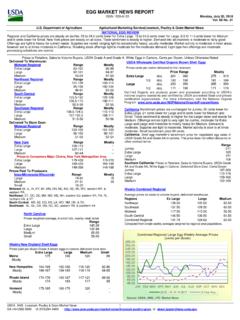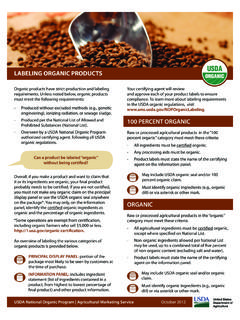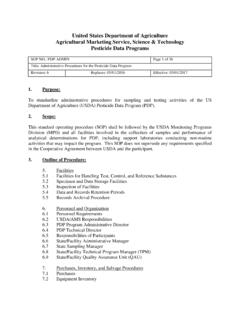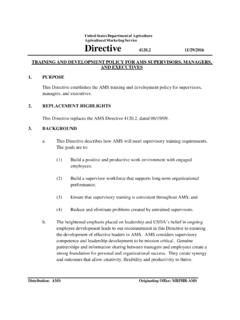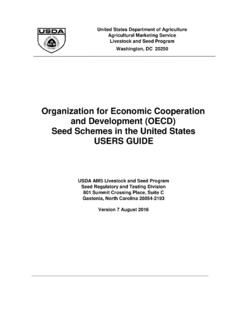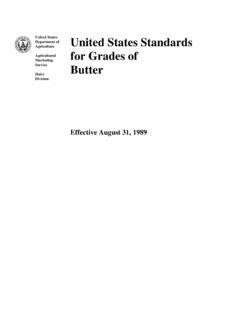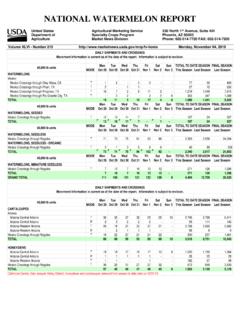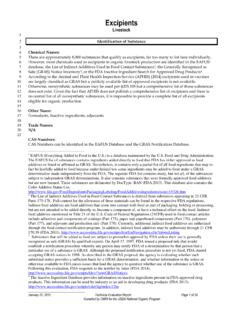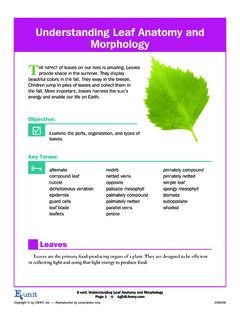Transcription of Fatty Alcohols (Octanol and Decanol)
1 Fatty Alcohols ( octanol and decanol ). Crops 1 Identification of Petitioned Substance: Fatty Alcohols 2. 3 Chemical Names: Octanol: InChI=1S/C8H18O/c1-2-3-4-5-6-7-8- 4 Fatty Alcohols ( Decanol, Octanol, 9/h9H,2-8H2,1H3; InChI. 5 Hexanol); octan-1-ol; decan-1-ol Key=KBPLFHHGFOOTCA-UHFFFAOYSA-N;. Canonical SMILES=CCCCCCCCO; EC Number=. 6 Other Name: Octyl-Decyl Alcohol, 1-Octanol, 1 203-917-6, 271-642-9, 606-925-1; ICSC. 7 Octanol, Alcohol, n-Octyl, n Octanol, n Octyl Number=1030, 1170; RTECS. 8 Alcohol, n-Octanol, n-Octyl Alcohol, 1-decanol; n- Number=RH6550000, RH795000;. 9 decanol; n-decyl alcohol; n-decyl alcohol, aluminum UNII=NV1779205D;. 10 salt; n-decyl alcohol, magnesium salt; n-decyl alcohol, 11 sodium salt; n-decyl alcohol, titanium salt Decanol: InChI= 1S/C10H22O/c1-2-3-4-5-6-7-8- 12 Trade Names: 9-10-11/h11H,2-10H2,1H3; InChI Key=. MWKFXSUHUHTGQN-UHFFFAOYSA-N.
2 Kleen-tac 85, O-Tac, Green Tac, Ten-Tac, Sucker- Canonical SMILES= CCCCCCCCCCO; EC. Plucker, Alfol 80, and others. Number= 203-956-9, 266-367-6, 253-173-1, 287- CAS Numbers: 621-2, 613-644-8; ICSC Number=1490; RTECS. Number=HE4375000; UN Number=3082, 1987;. 68603-15-6; 112-30-1; 66455-17-2; 85566-12-7. UNII=89V4LX79. Other Codes: 13. 14 Summary of Petitioned Use 15 A petition was received by the National Organic Program to add Fatty Alcohols , a mixture of aliphatic Alcohols , 16 hexanol, octanol and decanol to the National list 7 CFR (k) under the heading plant growth regulator. The 17 petitioned use for a mixture of Fatty Alcohols , consisting mainly of octanol and decanol , is topping and sucker 18 control on organic crops. 19 Characterization of Petitioned Substance 20 Composition of the Substance: 21 Monohydric aliphatic Alcohols containing six to ten carbons are called lower Alcohols .
3 Those containing twelve to 22 twenty carbons are called higher Alcohols (Atwood, 1963). Historically, lower and higher Alcohols were derived 23 from natural fats, oils and waxes hence the name Fatty Alcohols . Now a similar mixture of Fatty Alcohols that is 24 synthetically produced from petrochemical feedstocks, is widely available (NPCS Board of Consultants &. 25 Engineers, 2010). The C6-C12 linear Alcohols are used for plasticizers, surfactants, tobacco sucker control, mining 26 chemicals and in the manufacture of Fatty amines. 27 ALFOL 810 Alcohol, a product containing C6-C12 linear Alcohols was the first mixed Fatty alcohol product 28 registered with the Environmental Protection Agency as a tobacco topping and suckering agent. It was registered 29 by the Continental Oil Company under EPA reg. no. 39496-1. ALFOL 810 has the same composition as Mascol-80. 30 which is referenced in the petition with EPA registration number 63896-1 (Table 1).
4 31 The Alfol process to produce Fatty Alcohols combines aluminum, ethylene, hydrogen and air to synthetically 32 produce a mixture of lower and higher Alcohols (Atwood, 1963). However, sufficient quantities of plant derived 33 raw materials ( palm kernel oil) for this product are available. The Davy process is used to produce Fatty 34 alcohol from vegetable oils. Fair products, Inc., mentioned in this petition, and the Drexel Chemical Company 35 currently market Fatty Alcohols for tobacco sucker control. Drexel's tobacco sucker control agent is called Sucker- 36 Plucker. It contains 85% active ingredients ( Fatty Alcohols ) and 15% non-active ingredients. The non-active label 37 ingredient polysorbate-80 (tween-20) is a surfactant essential to the effectiveness of the Fatty Alcohols (Tso et al., _____. August 1, 2016 Technical Evaluation Report Page 1 of 16. Compiled by USDA, Agricultural Marketing Service, Agricultural Analytics Division for the USDA National Organic Program Technical Evaluation Report Fatty Alcohols ( octanol and decanol ) Crops 38 1975).
5 The EPA registration number for this product is 19713-35 (Table 1). It is derived from a Fatty alcohol 39 mixture typically containing C6 , C8 , C10 56% and C12 linear Alcohols (EPA, 1993, 2004, 2011). A. 40 similar product to Sucker-Plucker from Fair products, Inc. is cited in this petition as O-TAC Plant contact agent 41 (EPA reg. no. 51873-18) containing Octanol, decanol and dodecanol (Table 1). O-TAC is 42 currently described as a plant control agent for organic, purity residue clean (PRC) and maleic hydrazide free 43 tobacco. Table 1 provides information about several Fatty alcohol products for tobacco topping and suckering. Table 1 Fatty Alcohol Products for Tobacco Topping and Suckering Fatty Alcohol Composition on EPA EPA Registration Product Name registered Label Number (percent). C6 C8 C10 C12. ALFOL 810 1 39-47 51-59 1 39496-1. Mascol-80 - - 63896-1. Sucker-Plucker 19713-35.
6 O-TAC - - 51873-18. N-TAC 45 55 51873-18. 44. 45 Source or Origin of the Substance: 46 Petroleum derived feedstocks are the primary source material for synthetically produced medium chain 47 length lower and higher Alcohols . However, palm, palm kernel and coconut oils are also available sources 48 for producing Fatty Alcohols in the C8-C14 chain lengths (Reck, 1985). Because of the importance of Fatty 49 Alcohols in many industries, there is significant ongoing research in producing medium chain length Fatty 50 Alcohols via fermentation in yeast or bacteria, enzymatic reduction of Fatty acids. Although reports have 51 shown positive findings, this production route is not yet available commercially. Therefore, naturally 52 produced Fatty Alcohols are not yet available in sufficient quantities for commercial use as topping and 53 suckering agents (Wang, 2016). 54 Properties of the Substance: 55 Fatty Alcohols produced from palm oil, palm kernel oil and coconut oil by the Davy process for use as tobacco 56 suckering agents are aliphatic Alcohols with six to twelve carbons; however the most abundantly produced Fatty 57 Alcohols in this mixture are caproic alcohol, caprylic alcohol, and capric alcohol (Tables 2, 3, Fig.)
7 1). The primary 58 Alcohols exhibit some trends. For example, for each additional CH2- unit the normal boiling point increases 59 about 20oC, the specific gravity increases units and the melting point increases about 10oC in the lower 60 range and about 4oC in the higher range. Water solubility decreases and oil solubility increases with increasing 61 molecular weight. The Fatty Alcohols are all liquid with light natural fruity odors (NPCS, 2010). Both the density 62 and viscosity of Fatty Alcohols increase with increasing molecular weight (Rauf et al., 1983). 63 Specific Uses of the Substance: 64 Fatty Alcohols , octanol and decanol are used to chemically remove flower buds and suckers from tobacco 65 plants. Removal of the flower tops and the suckers encourages the growth of larger leaves. The use of Fatty 66 Alcohols is an alternative to two laborious hand operations in tobacco production.
8 Topping or removal of 67 buds or flowers and subsequent removal of suckers (lower leaves) by hand requires ten or more hours per 68 acre. A course spray of 5% decanol or a combination of decanol and octanol applied before bud formation 69 inhibits the formation of the bud. Fatty alcohol dripping down the stem of the plant inhibits sucker 70 formation. Yields are also increased with the use of this treatment (USDA-ARS, 1970). 71. August 1, 2016 Page 2 of 16. Technical Evaluation Report Fatty Alcohols ( octanol and decanol ) Crops Table 2 Physical properties of the low molecular weight Fatty Alcohols *. IUPAC name Common name CAS Molecular MW Hydroxyl Melting Boiling registry formula number point, point, C. number C ( ). 1-Hexanol Caproic alcohol 111-27-3 C6H14O 548 -52 157. 1-Heptanol Enanthic alcohol 111-70-6 C7H16O 482 -30 176. 1-Octanol Caprylic alcohol 111-87-5 C8H18O 430 -16 195.
9 1-Nonanol Pelargonic alcohol 143-08-8 C9H20O 388 -4 213. 1-Decanol Capric alcohol 112-30-1 C10H22O 354 7 230. 1-Undecanol - 112-42-5 C11H24O 326 16 245. 1-Dodecanol Lauryl alcohol 112-53-8 C12H26O 300 23 260. from (Condea, 2000). 72 Approved Legal Uses of the Substance: 73 Fatty (aliphatic) Alcohols containing a mixture of six, eight, ten and twelve carbons are approved by the US. 74 Environmental Protection Agency as the active ingredients for use as plant regulators for tobacco sucker 75 control. Synthetic hexyl-, octyl- and decyl-alcohol maybe safely used in food and in the synthesis of food 76 components provided that the alcohol's purity of the alcohol is 99% or greater. Synthetic Fatty Alcohols may 77 only be used as substitutes for and to the extent that naturally derived Fatty Alcohols are found in foods (US. 78 FDA, 21 CFR ). The US Department of Agriculture does not regulate the use of Fatty Alcohols for 79 tobacco sucker control.
10 80 Action of the Substance: 81 Tobacco grades are based on the manufacturer's use for cured leaf. Grades are determined by certain 82 physical and chemical properties. These properties are to a great extent determined by the position of the 83 leaf on the plant. Usually leaves on the lowest part of the plant are not considered useful and removed in 84 the suckering process (Calvert, 1956a). Tso (1964) first reported that alkyl esters of C9 to C12 Fatty acids 85 inhibited the growth of axillary buds when applied to tobacco plants that had been topped (Tso et al., 86 1965). It was later reported that both lower alkyl esters of the C8 to C12 Fatty acids and the C8 to C10 Fatty 87 Alcohols in aqueous emulsions selectively killed the terminal meristems of a wide variety of plants without 88 damaging the axillary meristems, foliage, or stem tissues of the plants (Cathey et al.)
